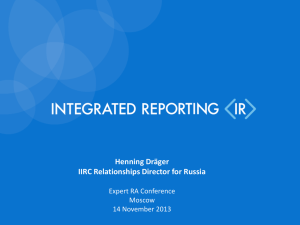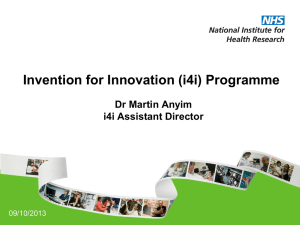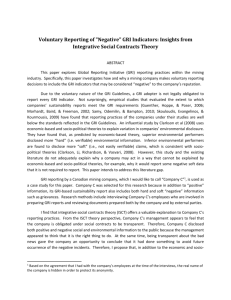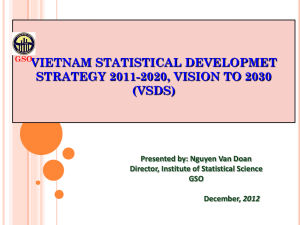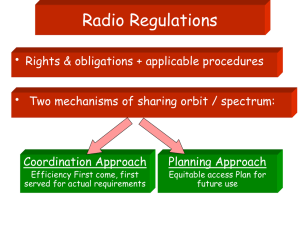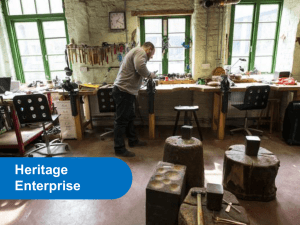GSO
advertisement
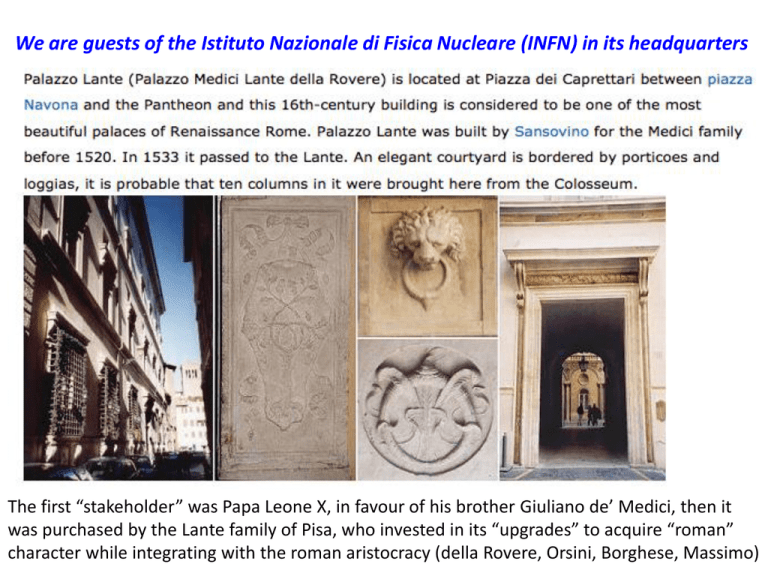
We are guests of the Istituto Nazionale di Fisica Nucleare (INFN) in its headquarters The first “stakeholder” was Papa Leone X, in favour of his brother Giuliano de’ Medici, then it was purchased by the Lante family of Pisa, who invested in its “upgrades” to acquire “roman” character while integrating with the roman aristocracy (della Rovere, Orsini, Borghese, Massimo) Cooperation for Implementation of Global Research Infrastructure Group of Senior Officials (GSO) Prof. Giorgio Rossi, Physics Department, Università di Milano and ESFRI Chair of 2014 meeting of GSO previous GSO results • • GSO agreed by ministers in 2008 to improve collaboration on GRIs (G8+N with Rotating Chair) Broad mandate to improve cooperation in GRIs • GSO Framework of principles and criteria for enabling collaboration to implement a GRI • Questionnaires to identify candidate projects of global scientific interest that are potentially compatible with the Framework Objective of the 5th GSO meeting - 1 • Analyse the 39 responses to the questionnaire • Identify the main motivations and expectations of full internationalization of these projects • Visit the Gran Sasso Underground Laboratory of the INFN and discuss with the management the possible evolution from"national research infrastructure with international scope" to GRI. • Identify areas of promising collaboration, priorities and formats Objective of the 5th GSO meeting - 3 • The GSO will discuss on the complementarity and possible synergies with other on-going international actions on Research Infrastructures: • A presentation by the OECD - Global Science Forum • A presentation by the Data Group on the Research Data Alliance. Objective of the 5th GSO meeting - 4 The GSO will discuss on the issues of • Communicating openly its results • Extending the membership • Defining the structure of the GSO Report 2015 • Drafting the GSO Report by the Spring 2015 to be discussed at the 6th GSO meeting on 20-21 April 2015. Next Steps • Focus on some opportunities emerging strongly from the 39 GRI proposals • Report to G8 in 2015 on GRIs ready for global cooperation • Extend the GSO mandate to facilitate the prioritization and implementation phase of GRIs Actions • Strengthening the Framework with the definition of the policy items discussed • Sketching a new mandate to facilitate GRI prioritization and implementation • Agree on issues of communication • Agree on openness and collaboration with GSF and RDA Round Table Presentations of SO and accompanying experts Federico Zuccari Peter Fletcher reports on Actions taken by the GSO since the last meeting in Abingdon (2013) and since the last G8 ministerial meeting in London (2013) (15’) Palazzo Lante Pomarancio - Lante Palace Analysis of responses to the Questionnaires and of new projects submitted Andrea De Candido (30’) Jacopo Tintoretto Senior Officials declare motivations/expectations about the proposed GRI(s) 10’ sharp ! • • • • • • • • • • • • • • Australia Brazil Canada People’s Republic of China France Germany India Italy Japan Mexico Russian Federation South Africa United Kingdom European Commission 5 projects 5 projects 4 projects 3 projects 1 project 1 project 2 projects 4 projects 3 projects 1 project 6 projects 2 projects 1 project 2 projects Ralph Dieter Senior Officials declare motivations/expectations about the proposed GRI(s) 10’ sharp ! • • • • • • • • • • • • • • Australia Brazil Canada People’s Republic of China France Germany India Italy Japan Mexico Russian Federation South Africa United Kingdom European Commission 5 projects 5 projects 4 projects 3 projects 1 project 1 project 2 projects 4 projects 3 projects 1 project 6 projects 2 projects 1 project 2 projects Presentation of the Global Science Forum / OECD Frédéric Sgard (30’) Giacinto Calandrucci Presentation of the Data Group and Research Data Alliance Carlos Morais Pires (15’) Romanelli Presentation of the structure of the GSO Report 2015 Ralph Dieter (15’) Carlo Rainaldi Senior Officials discuss policy issues as identified in the videoconference 15’ sharp ! • Promoting Access to Facilities DE, EC, FR • Access to Data and Data Management Data Group/USA/MX • Evaluation Criteria and Priorities IT, DE, CN, CA • Project management and Life Cycle USA, UK, CN • Legal Framework for GRIs EC Day One Conclusions • GRI questionnaires • Main expectations / motivations • Synergies with GSF-OECD and RDA • Structure of the GSO 2015 Report to G8 • Policy on Access / etc. Day Two • • • • • - Be sure you are registered on the right return bus ! Evaluation Criteria and Priorities in establishing GRIs GRI can be prompted by: a) International agreement on urgent action for addressing a science issue or a great challenge b) Extension at global level of monitoring infrastructures (oceans, solid earth, atmosphere, solar system, infectious diseases, epidemia, international cohorts…) c) Adoption of GRI status of internationally used RIs. Establishment of World Laboratories a-type GRI case - - International science community agrees on scope and expected discovery and demonstrates to several Governments the benefit to operate internationally/globally. International outlook bodies (GSF) support. GSO informs G8+N that a GRI can be the winning solution and carry benefits to many/all Countries. The GRI framework is put to a stress-test. An intergov. treaty/agreement is prepared and site selection is discussed/negotiated. Whatrrole for GSO: fostering and facilitating contacts (group of wide people)? Leading the science and diplomatic approach? Acting as global reviewing committee? Other… b-type GRI case The effectiveness of research requires full data sets for monitoring and properly modelling the earth dynamics (climate, weather, desertification, ice-melting, ozone screen…) Evaluation of effectiveness of existing relevant regional RIs and evaluation of their networking at global level vs. replacing technology for an altogether novel GRI. GSO informs G8+N that a globally distributed GRI integrating the state-of-the-art existing observatories or upgraded observatories can be the winning solution and carry benefits to all for a sustainable cost The GRI framework is put to a stess-test An intergovt treaty/agreement is prepared and headquarters/data center selection are discussed/negotiated What role of GSO towards already installed GEO SS ? Overarching executive or steering committee ? Organization level (CERN, ITER…) or new global RI “instruments2 (LHC for example) ? c-type GRIs An existing laboratory offering international access offers to integrate more international programmes and contributions, opening to a global governance. The science community at large recognizes the advantages to invest and access to that laboratory, or to federate with it complementary facilities. A science outlook is updated as a function of two scenarios: the integration in a World-Laboratory dedicated to a specific objective (physics, genomics, space, energy…) vs. maintaining independent dispersed efforts. Conclusions are reached on necessity/opportunity/sustainability of the different options The GRI framework is put to a stress-test Evaluation Criteria in establishing GRIs The Global dimension must be a clear added value, or a precondition for the research results (Time and money value) The GRI must substitute or complement/coordinate the national/regional on-going efforts and allow to reach an overall sustainable cost and increase of return from investment The GRI must offer data and results of paramount interest and, under proper policy, of open access to foster scientific knowledge and innovation skills for societal and economical actions. Priority Criteria in establishing GRIs The GRI concept will be prioritized by the readiness of the proponents and supporting governments (national strategies) A pragmatic approach shall be adopted as a GRI system will require time and trials to become an effective reality A priority would be set by the agreement on the grand challenges. Lower priority will be given to projects that overlap in scope with existing GRIs. Clear acceptance by the world scientific community and recognition of global sustainability by a critical mass of Governments will be priority elements. EPOS – European Plate Observing System Integrates Solid Earth Science research infrastructures for seamless access to pan-European data and services Guarantees open access to data and services for cross-disciplinary and transnational research Fosters scientific, technological and ICT innovation for successfully addressing global Grand Challenges in Earth science Improves geo-hazard assessment, risk mitigation, and sustainable management of georesources for a safe and prosperous society EPOS – European Plate Observing System EPOS involves and integrates a large number of diverse infrastructures and communities in Solid Earth Science The EPOS federated approach aims at increasing their efficiency, improving and simplifying their use, and allowing multilateral strategic coordination for their sustainability, operation, and development EPOS – European Plate Observing System EPOS will offer to diverse communities data products, tools, and services for intelligible integrated analyses Accessible data and new e-infrastructures bring novel cross-fertilization of ideas and lead to innovative research, new discoveries and applications for society www.mousephenotype.org Thousands of registered users world-wide; gene knockout mice shipped to thousands of laboratories for in-depth research. Over 3,500 IMPC mouse strains have been produced, with phenotype data for 1500 of these strains available already. Another 16,000 genes to be www.mousephenotype.org completed over the next 7 years. Monterotondo Mouse Clinic (MMC) The Monterotondo Mouse Clinic is the Italian partner of the International Mouse Phenotyping Consortium (IMPC). Today: >100 open access users/year, production and dissemination of requested mouse mutant models of human diseases. Tomorrow: full operation capacity > 350 international users/year Open real-time web-access to IMPC phenotypic, genotypic, disease model data of individual mouse mutant models www.mousephenotype.org Research Infrastructure for Heritage Science – RIHS Heritage preservation is a global challenge requiring global cooperative and multidisciplinary approaches. RIHS supports advanced research in heritage science through access to an integrated platform of services and tools including mobile diagnostic instruments, large scale facilities and scientific archives. • • Heritage science is founded on the interdisciplinary combination of knowledge from arts and humanities (conservation, archaeology, history, art history, ethics etc.), and from science and technology (chemistry, physics, mathematics, anthropology, biology, geology, computer sciences and engineering, etc.). Heritage science supports the various aspects of tangible and intangible heritage conservation, interpretation and management. www.iperionch.eu Research Infrastructure for Heritage Science – RIHS • • 43 institutions from 18 EU member states currently joining the proposal for establishing RIHS in Europe. (700 users/year + 1000 virtual access users, remote access heritage datasets >500.000/year) More than 22 institution from all over the world already applied to be associated to RIHS. (International potential >4-fold increase in users) Hosting of the legal entity proposed by the intergovernmental organization ICCROM-International Centre for the Study of the Preservation and Restoration of Cultural Property www.iperionch.eu Research Infrastructure for Heritage Science – RIHS • RIHS will result from the joining of several on-going initiatives: • www.iperionch.eu www.ariadne-infrastructure.eu The Palaeoanthropology initiative was initiated by the European Commission at the Palaeoanthropology and Cultural Heritage session at the International Conference on Research Infrastructures, ICRI2014 (http://www.icri2014.eu/sessions/parallel-thematic- sessionspalaeoanthropology-cultural-heritage). • CHARISMA-Cultural Heritage Advanced Research Infrastructures: Synergy for a Multidisciplinary Approach to Conservation/ Restoration (EU FP7), www.charismaproject.eu • Eu-ARTECH-Access, Research and Technology for the conservation of the European Cultural Heritage (EU FP6), www.eu-artech.org www.iperionch.eu Research Infrastructure for Heritage Science – RIHS • • • The global value and impact of RIHS as a world-wide distributed infrastructure will benefit from the involvement of prominent international institutions working in the field of heritage science. International partners are seminal to introduce in their regional ecosystems the innovations and the cutting-edge tools provided by the global infrastructure. They are also key stakeholders in involving local communities in study and preservation of heritage, and play major roles in dissemination, communication, use of best practices, standards and protocols. Access to archives (of restoration data, scientific data, ...) is one of the services that RIHS will provide to the research communities. International partners involved in the infrastructure can provide their scientific and practical knowledge with far better visibility to scientists in the global community. www.iperionch.eu LNGS • LNGS now – National laboratory run by INFN – national governance – addresses most pressing challenges in Astroparticle Physics – Peer review of all research proposals by an International Scientific Committee – Strong international participation to research : • 2/3 of users from international institutions (~600/900) • Italy, Germany, USA and Russia account for 3/4 of users • LNGS as GRI – Broader international participation to research – International participation to governance – International participation to costs with cash and in-kind contributions Palazzo Lante Onorio Longhi
